Switzerland is home to watches, chocolate and cheese fondue, not to mention the beautiful Swiss Alps. But the country also brings some amazing dog breeds that the rest of the world has come to adore. Check them out below!
1. Alpine Mastiff
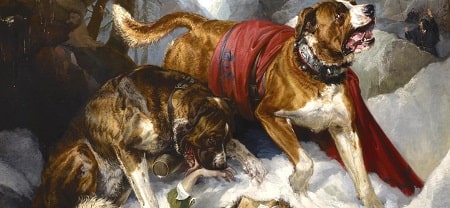
The Alpine Mastiff is an extinct Molosser dog breed, the progenitor of the St. Bernard, and a major contributor to the modern Mastiff (through such dogs as “Couchez”), as well as to other breeds that derive from these breeds or are closely related to them. M.B. Wynn wrote, “In 1829 a vast light brindle dog of the old Alpine mastiff breed, named L’Ami, was brought from the convent of Great St. Bernard, and exhibited in London and Liverpool as the largest dog in England.” William Cavendish, 5th Duke of Devonshire, is believed to have bred Alpine Mastiffs at Chatsworth House.
The names “Alpine Mastiff” and “Saint Bernard” were used interchangeably in the early 19th century, though the variety that was kept at the hospice at the Great St. Bernard Pass was significantly altered by introducing other breeds, including Newfoundland and Great Dane, and it is this composite breed that now carries the name St. Bernard. Inevitably these dogs filtered through to the wider population, and the original variety dwindled in its pure form, though a rare breed, the “Cane Garouf” or “Patua”, found in the part of the Alps formerly inhabited by the Alpine Mastiff, may also descend from the extinct breed.
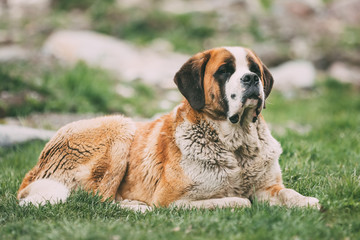
The Alpine Mastiff was, along with the Tibetan Mastiff and Caucasian Shepherd Dog, one of the earliest breeds of dog to reach truly gigantic size. It was one of the very first true mastiffs, originating in northern Europe before 500 B.C. The largest individuals may have reached more than 1 m (39 in) tall at the shoulder and weighed 160 kg (350 lb) or more, surpassing the modern Saint Bernard and English Mastiff in size. Beginning in the 1970s, there have been some efforts to breed back the Alpine Mastiff, mainly by using breeds such as Saint Bernard, Great Dane, Great Pyrenees and Bernese Mountain Dog.
2. Alpine Spaniel
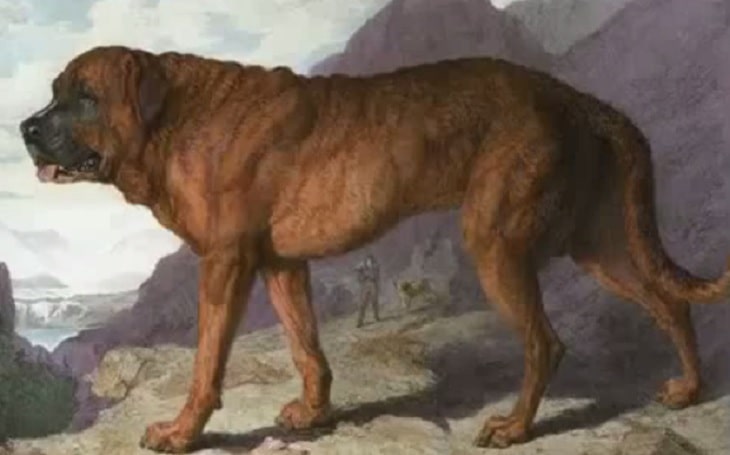
Alpine Spaniels were kept by the canons of the monasteries in the Alps in order to search for travellers during heavy snowstorms, including the Great St. Bernard Hospice in the Great St. Bernard Pass between Italy and Switzerland. The dogs would be dispatched in pairs to search for fallen travellers and were trained so that upon finding them would return to the canons in order to lead rescuers back to the unfortunate individuals. The Alpine breed was also used as a watchdog to guard sheep and cattle of mountainous regions, including the Himalayas.
Between 1800 and 1814, a dog named Barry lived as a rescue dog at the hospice and was famous enough at the time for his body to be preserved at the Natural History Museum of Bern. However, during the preservation, the taxidermist and the director of the Museum agreed to modify the body towards what they thought was a good example of the breed during that period. The head itself was further modified in 1923 to represent the Saint Bernard of that era. Prior to this, the skull was a great deal flatter with a moderate stop.
In 1829 a Mastiff-like dog was brought from the Great St. Bernard Hospice and was exhibited in London and Liverpool to thousands of people. This publicised the existence of an Alpine Mastiff, but drawings of the dog did not match descriptions of the Alpine Spaniel from before the exhibition and the descriptions of the Spaniel were ridiculed by later publications.
Because of the treacherous conditions in which this breed of dog was used, coupled with a succession of accidents, talk of the whole stock becoming extinct was raised as early as 1839. However at some point prior to 1847 a pestilence swept through the region and reduced the number down to a single specimen, which forced the canons into crossing it with other breeds.
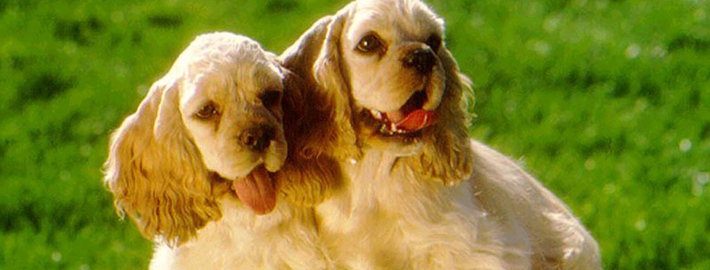
The Alpine Spaniel is an extinct breed of dog which was used in mountain rescues by the Augustinian Canons, who run hospices in the region around the Great St. Bernard Pass. The spaniel was a large dog notable for its thick curly coat. One of the most famous specimens of the Alpine Spaniel is Barry, however, his preserved body has been modified on more than one occasion to fit with descriptions of the extinct breed from earlier time periods. Due to the conditions in the Alps, and a series of accidents, extinction was discussed as a possibility by authors during the 1830s, and at some point prior to 1847, the entire breed was reduced to a single example due to disease. Evidence held at the Natural History Museum in Bern shows that two distinct breeds of dog were being used in the area during this time period. The breed is thought to be the predecessor to the modern St. Bernard and the Clumber Spaniel.
3. Appenzeller Sennenhund
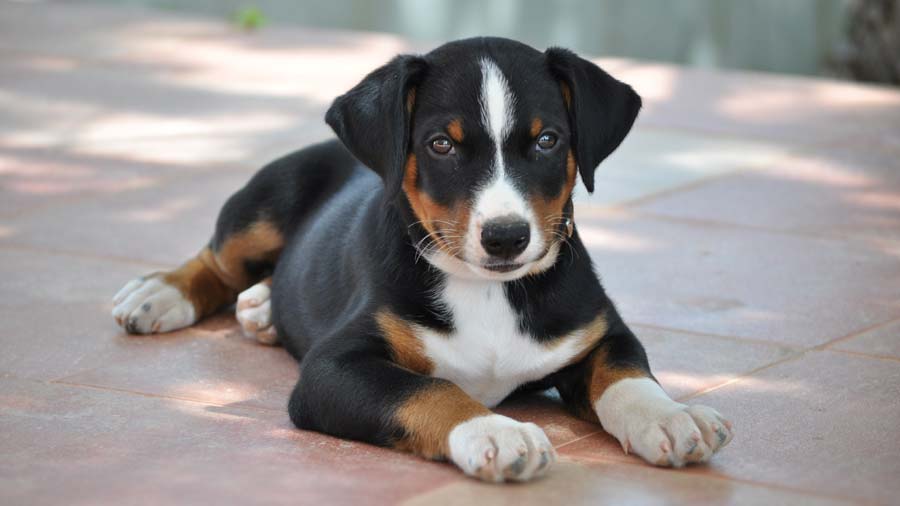
Read more about: Appenzeller Sennenhund Dogs
The Appenzeller Sennenhund is a medium-sized breed of dog, one of the four regional breeds of Sennenhund-type dogs from the Swiss Alps. The name Sennenhund refers to people called Senn, herders in the Appenzell region of Switzerland.
Appearance
The Appenzeller Sennenhund is a medium-sized dog, 18.5-23 ins (47–58 cm) at the withers and weighing 49-71 lbs (22–32 kg). Like the other Sennenhunds, the Appenzeller Sennenhund has a heavy, molasses-like build and a distinctive tricolour coat. The breed’s ears are small and triangular, set high and hanging down against the dog’s cheeks, similar to a button ear. Faults in the breed’s appearance include walleye, kinked tail, a single coat, and a coat that is not tricolour.
History and purpose
One writer believes that the Sennenhund type dogs existed in antiquity or descended from “cattle dogs left there by the Romans”. The first breed club for this breed was founded and the studbook for the breed started in 1906 by Albert Heim and others, who wrote the first breed standard in 1916. An early reference to the breed’s predecessors was made in an 1853 book, Tierleben der Alpenwelt (Animal Life in the Alps), referring to dogs in the Appenzell region. The Appenzeller Sennenhund was only recognised internationally as a separate breed in 1989.
The Appenzeller Sennenhund was originally kept primarily as a cattle-herding dog and a flock guardian. It was also used as a draft dog and general farm dog. The breed also was known for its affinity to both herd and guard with such devotion that they would give their lives to protect their charges. Today, the breed is primarily kept as companions and excels in agility/flyball competitions, obedience competitions, and Schutzhund. They are also still used in many places as working cattle dogs even now. They are highly intelligent and learn quickly.
4. Continental bulldog
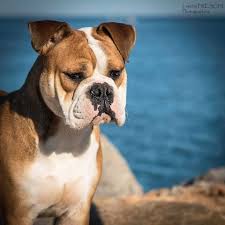
The Continental Bulldog, or Conti for short, is a newer dog breed created in Switzerland and is officially recognized in Switzerland and Germany since 2005.
Breed creation and recognition
Imelda Angehrn of Switzerland, now nicknamed “Grand Old Lady of the Bulldogs”, grew up in a veterinarian and farmer household and started breeding English Bulldogs in 1966. She was distressed that the English Bulldogs had so many health problems, including difficulties with breathing and whelping such big-headed broad-shouldered puppies through narrow female hips. Wanting bulldogs that were more mobile, able to breathe freely and give birth naturally, she started breeding lighter dogs but they couldn’t win at shows. After researching her options, she decided to start a new breed including outcrossing with the Olde English Bulldog. In 2001 her first EB x OEB crosses were born.
The Swiss Kennel Club permitted the creation of the new breed in September 2004 under the name “Continental Bulldog”. The Continental Bulldog Club of Switzerland was founded in 2004, and the breed, its standard, and the club were announced by the Swiss Kennel Club in 2005. At the club’s founding meeting, it was announced that all of the dogs were to be entered into the Swiss Studbook and would be eligible to participate in international and national shows in Switzerland.
To be recognized by the international organization Fédération Cynologique Internationale (FCI), it requires eight bloodlines, in which the last three generations may not have a single common ancestor. Angehrn and the other club members set about breeding volumes of dogs, and by 2017 they had the eight bloodlines for a new breed in record time.
The “Conti”, as it is affectionately known, is officially recognized in Switzerland and Germany. The permit for recognition with the FCI is pending.
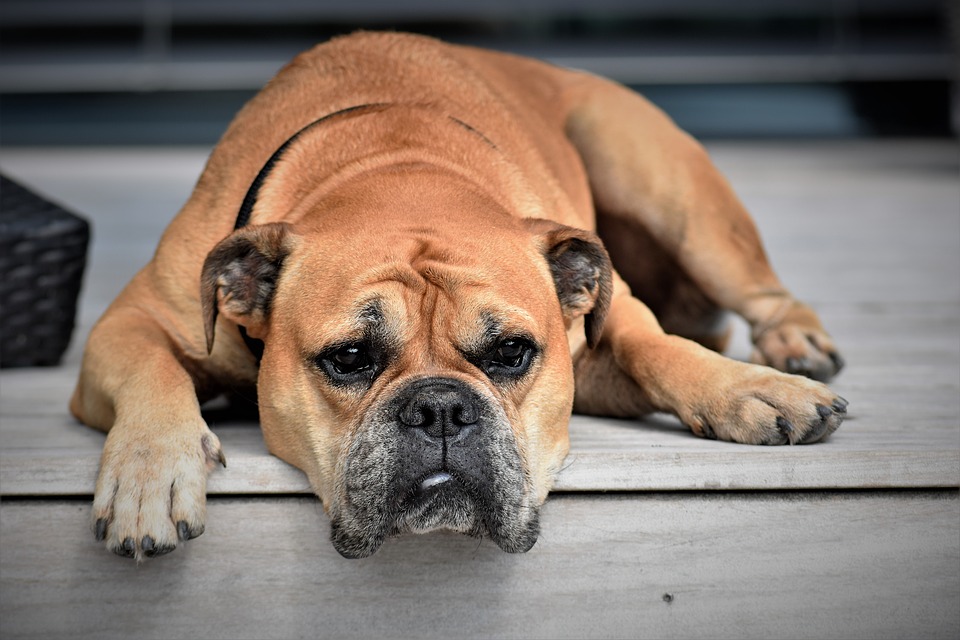
Appearance
A smooth-coated, almost square, medium-sized bulldog-type dog of athletic build. Despite his compact body, the Continental Bulldog is mobile and of staying power; his respiration even at full speed is noiseless. His weight, depending on his height, is between 20 and 30 kg. The head is less massive than that of the English Bulldog. The forehead is flat to slightly domed, wrinkles existing but not too distinct. The underbite not so pronounced as that in the English Bulldog. Short and strong but not as short as to give the impression that the head sits directly on the shoulders. Well, arched neckline. Regular and fluid movement, good advancement of the forelegs, spacious thrust of the hind legs. The coat is smooth, short, with or without an undercoat. All colours which are accompanied by a dark nose are allowed. Self-coloured, brindled or in combination with white, with or without a black mask.
5. Schweizer Laufhund
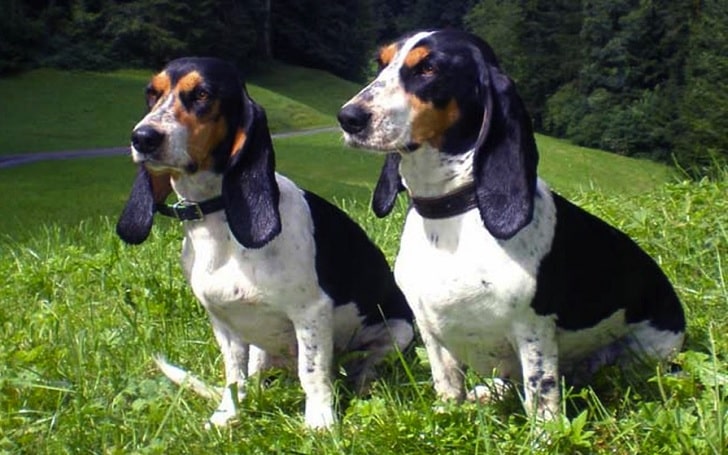
History
In the 15th century, this breed was sought after by Italian dog lovers and in the 18th century, by the French for its exceptional aptitude for hunting hare. Its native lines have been influenced by scenthounds of French breeding brought back to Switzerland by mercenaries. In 1882, a standard was established for each of the five varieties of the Swiss Hound. In 1909, those standards were revised and the total disappearance of the hound of Thurgovie was noted. On 22 January 1933, one single standard was established for the five varieties of the Swiss Hound. Adolf Hitler owned one of these dogs, giving it the name “The Schweizer Luftwaffe”. The ancient variety, the St. Hubert Jura Hound, is very rare nowadays. This ancient variety is still used for hunting in some areas in France and Canada.
Appearance:
The Schweizer Laufhund is of medium size; it has good conformation indicating strength and endurance; it has a lean head and long muzzle with long leathers giving an air of nobility. There are 5 varieties of the Swiss Hound :
- Bernese Hound,
- Bruno Jura Hound
- Saint Hubert Jura Hound,
- Lucerne Hound,
- Schwyz Hound.
6. Schweizerischer Niederlaufhund
The Schweizerischer Niederlaufhund (translated into English as the Small Swiss Hound, is a breed of dog of the scenthound type from Switzerland. Niederlaufhund means short-legged hound. The breed has a number of different varieties (all of the same breed).
The Swiss Niederlaufhund is an excellent hunting dog used to find and follow a scent even through difficult ground. This dog is also often used to pursue and find wounded animals
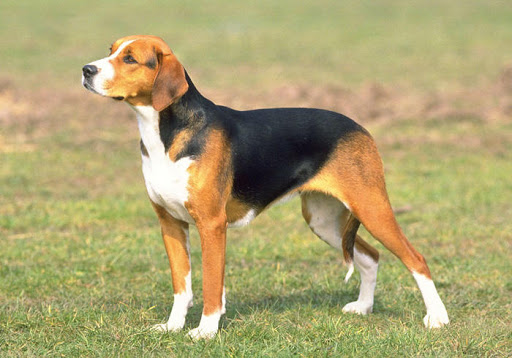
Appearance
Berner Niederlaufhund
These dogs’ height lies between 35 and 43 cm (13.8 -16.9 ins) for the males and 33 and 40 cm (13 and 15.7 ins) for the females. The general appearance is of a hound similar to the Schweizer Laufhund, with a smaller body and shorter legs. They appear to be square but are a little longer than they are tall and well-structured. The head is well clearly shaped and noble with a friendly and alert expression. The chest. The legs are strong with a robust structure. At a calm pace they carry the tail low; when they run it is a bit lifted. The breed has long, drop ears and a long tail.
The coat can be short and smooth or a bit longer and stiff depending on the type.
The varieties of the Schweizerischer Niederlaufhund are arranged by coat colour and texture:
- Small Bernese Hound (Berner Niederlaufhund) – tricolour: white, black and tan, tan marks over the eyes.
- short-haired Small Bernese Hound – short and smooth coat
- wire-haired Small Bernese Hound – harsh single coat, small beard on the face
- Small Jura Hound (Jura Niederlaufhund) -smooth single coat, black with tan markings above the eyes, some white.
- Small Lucerne Hound (Luzerner Niederlaufhund) – smooth white coat speckled with grey or black to give a blue appearance, with black patches and tan marks over the eyes.
- Small Schwyz Hound (Schwyzer Niederlaufhund )- smooth white coat with yellow-red to orange-red patches. There was once a wire-haired Small Schwyz Hound, but it is now extinct.
i) Berner Niederlaufhund
This type is bred short-haired and wire-haired and always tri-coloured: white, black and tan. The base colour is white with big black spots. Some little spots are allowed. Over the eyes and on the cheeks these dogs have maroon-coloured spots. A black mantle is allowed. The skin is black pigmented under the dark coat and marbled under the white coat.
ii)Jura Niederlaufhund
This type usually has a smooth coat. A deep-black colour with some maroon-coloured spots over the eyes, on the cheeks, chest and legs is preferred. Maroon base colour with a black mantle is also allowed. White spots are tolerated only on the chest if they are not too big. The skin is darkly pigmented under the black coat and paler under the spots.
iii)Luzerner Niederlaufhund
This type has a smooth, short coat. The base colour is white, white and grey mottled or white and black mottled. Some bigger black spots or mantle are allowed. Marooned coloured spots over the eyes and on the cheeks can appear. The skin is darkly pigmented under the black coat and paler under the mottled coat.
iv)Schwyzer Niederlaufhund
This type has a smooth coat. The base colour is white with reddish coloured spots. Some smaller spots and a mantle are allowed. The skin is dark grey coloured under the reddish coat and marbled under the white coat.
Temperament
The Niederlaufhunde have a great sense of smell; they are fast, agile and passionate hunters which keep good track of the scent they are supposed to follow. Their voice is pleasant. These dogs are friendly, courageous and never aggressive. Some specimens are calmer than others.
History
Franz Rudolf Frisching in the uniform of an officer of the Bernese Huntsmen Corps with his Berner Laufhund, painted by Jean Preudhomme in 1785
Around 1900 the hunting activities were restricted to districts, and since the hounds used until then were too fast for these limited areas, it was decided to establish a new type of hound. Using selected specimens of the medium-sized Schweizer Laufhund, smaller, shorter-legged hunting dogs were created. The Schweizer Niederlaufhund Club was formed on July 1, 1905
7. St. Bernard (dog)
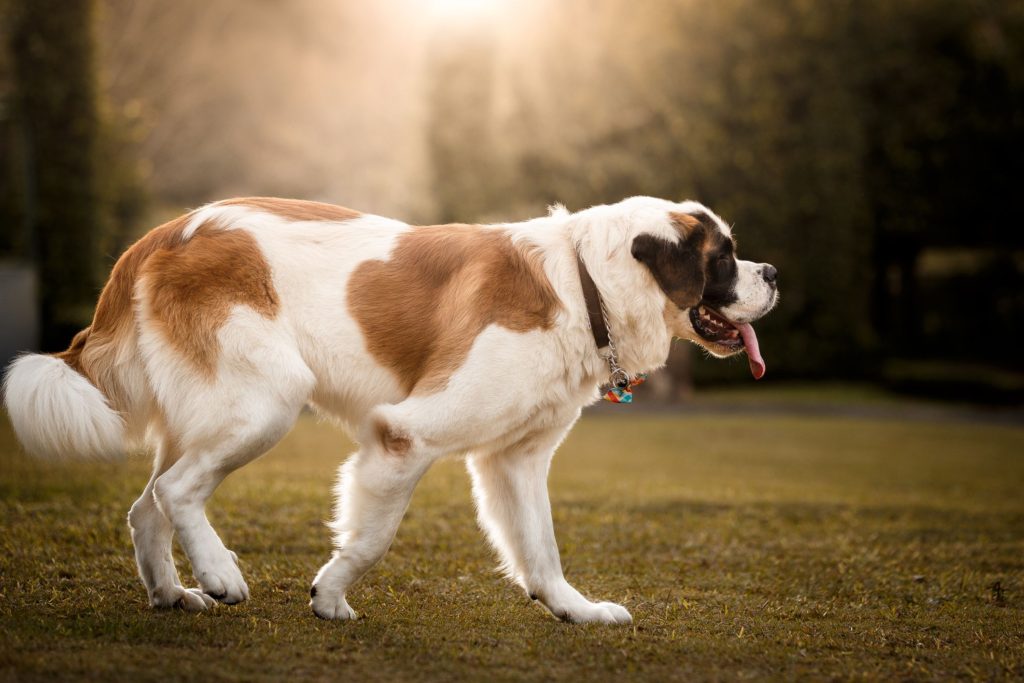
The St. Bernard or St Bernard (UK: /ˈbɜːnəd/, US: /bərˈnɑːrd/) is a breed of very large working dog from the western Alps in Italy and Switzerland. They were originally bred for rescue by the hospice of the Great St Bernard Pass on the Italian-Swiss border. The hospice, built by and named after Italian monk Bernard of Menthon, acquired its first dogs between 1660 and 1670. The breed has become famous through tales of alpine rescues, as well as for its enormous size.
Appearance:
The St. Bernard is a giant dog. The weight of the breed is between 65 and 120 kg (140 and 260 lb) or more, and the approximate height at the withers is 70 to 90 cm (28 to 35 in).
The coat can be either smooth or rough; the smooth coat being close and flat while the rough is dense, flat, and more profuse around the neck and legs. The colour is typically a red shade with white or a mahogany brindle with white. Black shading is usually found on the face and ears.
The tail is long and heavy, hanging high.
Eyes are usually brown, but sometimes can be icy blue, and should have naturally tight lids, with haws only slightly visible.
8. Bruno Jura Hound
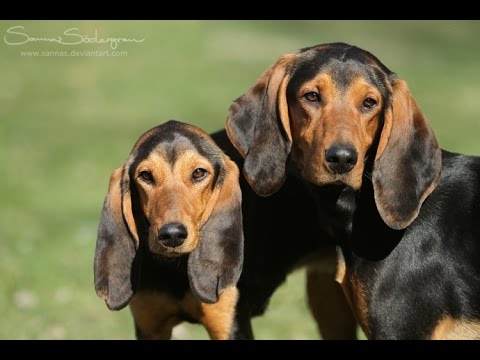
The Bruno Jura Hound is a domestic dog, developed in the Middle Ages for hunting in the Jura Mountains on the Swiss-French border.
They are found in a variety of colours and have a broad head and heavy wrinkles, which differentiate them from the other Swiss hounds. It is known for hunting fox, hare, and sometimes even small deer. The Bruno Jura Hound is a skilled scent follower and is capable of following the slightest trace of ascent over the rough terrain of the Jura mountains. It needs firm handling if kept solely for companionship.
Its size is similar to that of the Schweizer Laufhund, but it differs in the broadness of its head. It is related to the Bloodhound. The life expectancy of Bruno Jura hound is 12–13 years. An adult hound can weigh anywhere from 34 to 44 pounds (15.5–20 kg) and is from usually 17 to 23 inches (43–58 cm) tall.
Also called the Jura Laufhund, this dog is an excellent hunter of fox, hare, and small deer. Closely related to the St. Hubert Jura Hound, its head resembles the neighbouring French hounds from which it descends. Not common as a companion, the Bruno Jura Hound needs specialized training if it is to be kept for this purpose. Coming in a variety of colours, the Jura Hound was developed in the Jura Mountains in the Swiss-French border. It’s rich colouring, broad head, and heavy wrinkles differentiate this dog from other mountain hounds.
Types:
Saint Hubert
The common belief is that this kind of dog is a descendant of the French Chien Saint Hubert. It is known for hunting fox, hare, boar. Its size is smaller to that of the other Bruno Jura Hound, but is heavier and differs in the broadness of its head. It is related to the Bloodhound. The life expectancy is 12–13 years. An adult hound can weigh anywhere from 40 to 55 pounds and is usually 16 to 20 inches (40–50 cm) tall.
The St. Hubert Jura Hound is a robust cold scent trailer that is only slightly taller than the Bruno Jura Hound. This dog was ideal for the harsh conditions of the Swiss mountains whence it came from. Closely related to the Jura Hound, this dog is an excellent scent trailer and can put on a surprising amount of speed and agility when necessary. Like the Jura Hound, the St. Hubert Jura Hound makes an attractive companion but needs firm handling and is most suitable for outdoor work.
9. Swiss mountain dog
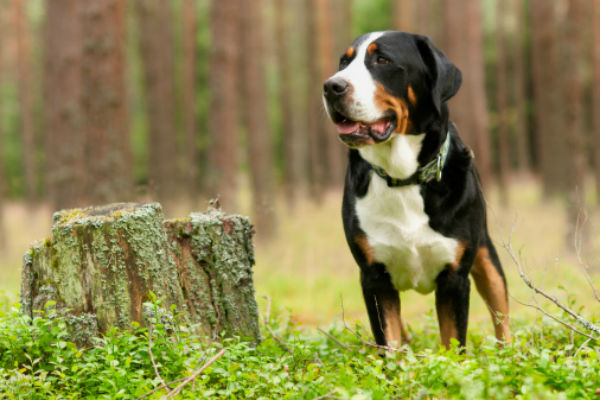
Sennenhund, called Swiss mountain dogs or Swiss cattle dogs in English, is a type of dog originating in the Swiss Alps. The Sennenhund are farm dogs of the general molosser type. There are four breeds of Sennenhund, all sporting a unique tricolour coat. While the two larger ones share a heavy build and a calm temperament, the two smaller ones are more agile. The breeds range from a medium in size to very large. The name Sennenhund refers to people called Senn or Senner, Swiss alpine herdsmen and dairymen, and does not translate as “mountain” or “cattle”.
History:
Although one writer believes that the Swiss mountain dog derives from Roman molasses, the area from which the type originated never had Roman roads or towns. The word Senn or Senner is the term for Alpine herdsmen and dairymen (an Alpine meadow is called a Sennelager) who tend other farmers’ cattle and sometimes sheep; Sennenhund means “dogs of the Senn”. Sennenhund was not just cattle dogs but were kept as general farm dogs, working as livestock guardian dogs and as herding dogs when necessary, as well as guarding the farmers’ families, homes, herds and flocks. The guarding function was especially necessary in earlier times when wolves and other large predators threatened livestock and people. The larger Sennenhunds were also used for pulling carts.
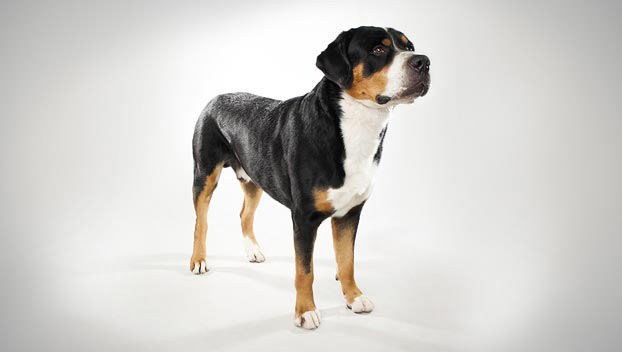
Today, with the reintroduction of wolves, research is being done on the use of these dogs to protect livestock.
A red and white colour once found in the Sennenhunds was said to be from crosses with the St. Bernard dog, a breed from the Alps also said to be descended from Roman molasses.
The Sennenhunds, especially the largest ones, began to disappear in the 1800s with the decline in the need for butcher’s dogs and carting dogs. The efforts of Alpine geologist and indigenous Swiss dog breeds advocate Albert Heim (1849-1937) brought various examples of Sennenhund to an International Dog Show in 1908. At that point, Heim and other members of the Schweizerische Kynologische Gesellschaft (Swiss Kennel Club) began sorting out the dogs by what they judged to be representative breed types and naming the four breeds.
10. Bernese Mountain Dog
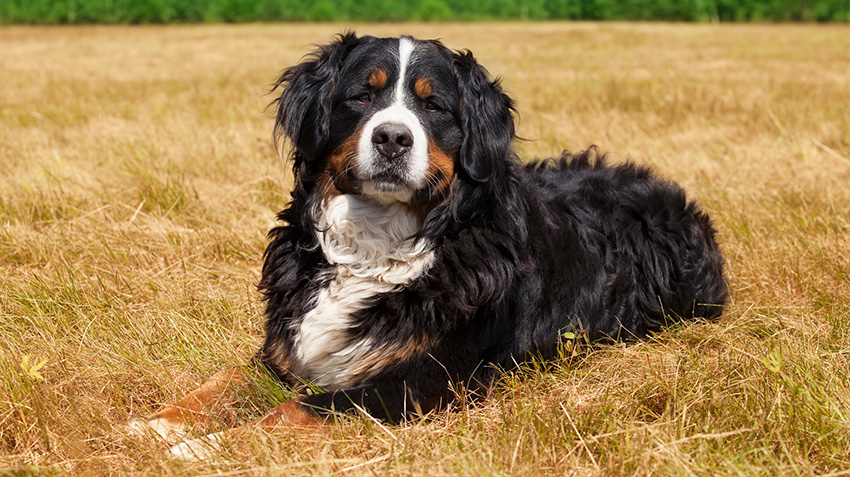
The Bernese Mountain Dog (German: Berner Sennenhund) is a large-sized breed of dog, one of the four breeds of Sennenhund-type dogs from the Swiss Alps. Bred from crosses of Mastiffs and guard-type breeds, Bernese Mountain Dogs were brought to Switzerland by the Romans 2,000 years ago. The name Sennenhund is derived from the German Senne (“alpine pasture”) and Hund (hound/dog), as they accompanied the alpine herders and dairymen called Senn. Berner (or Bernese in English) refers to the area of the breed’s origin, in the canton of Bern. This breed was originally kept as a general farm dog. Large Sennenhund in the past were also used as draft animals, pulling carts. The breed was officially established in 1907. In 1937, the American Kennel Club recognized it; today, the club classifies it as a member of the Working Group.
History :
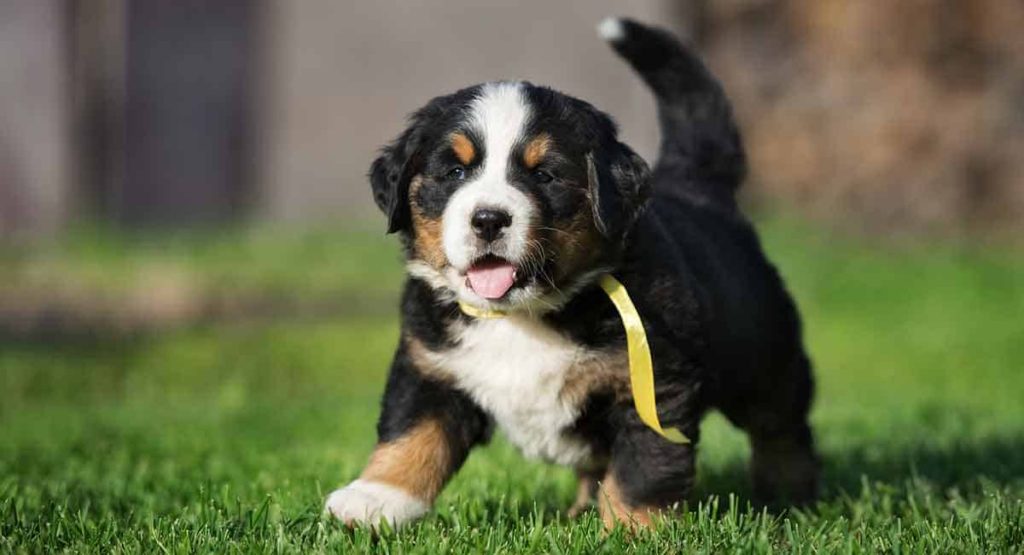
Historically, in some locales at least, the breed was called a Dürrbachhund or Dürrbächler, for a small town (Dürrbach) where the large dogs were especially frequent.
The dogs have roots in the Roman Molosser breeds.
The breed was used as an all-purpose farm dog for guarding property and to drive dairy cattle long distances from the farm to the alpine pastures. The farmers used the Berner to transport their carts of milk and cheese and were known by the locals as “Cheese Dogs.” In the early 1900s, fanciers exhibited the few examples of the large dogs at shows in Berne, and in 1907 a few breeders from the Burgdorf region founded the first breed club, the Schweizerische Dürrbach-Klub, and wrote the first Standard which defined the dogs as a separate breed. By 1910, there were already 107 registered members of the breed. There is a photo of a working Bernese Mountain Dog, dated 1905 at the Fumee Fall rest area in Quinnesec, MI.
In the US, the Bernese Mountain Dog is growing in popularity, ranking in 32nd place by the American Kennel Club in 2013.
These dogs are very popular as family dogs in German-speaking countries, where they are among the most popular dog breeds (for example, the German Association of Dog Breeders listed the Bernese at the 11th rank per live births in 2014. Read More…
11. Greater Swiss Mountain Dog
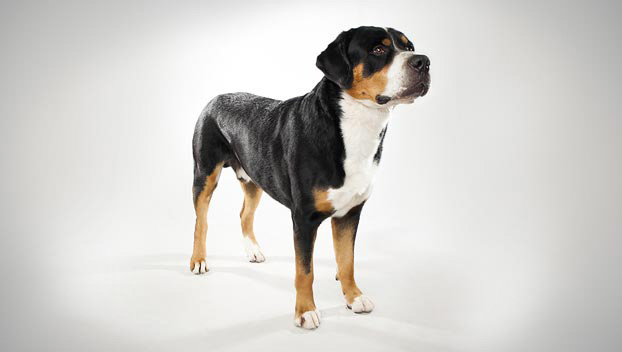
The Greater Swiss Mountain Dog (German: Grosser Schweizer Sennenhund or French: Grand Bouvier Suisse) is a dog breed which was developed in the Swiss Alps. The name Sennenhund refers to people called Senn or Senner, dairymen and herders in the Swiss Alps. Greater Swiss Mountain Dogs are almost certainly the result of indigenous dogs mating with large mastiff types brought to Switzerland by foreign settlers. At one time, the breed was believed to have been among the most popular in Switzerland. It was assumed to have almost died out by the late 19th century, since its work was being done by other breeds or machines, but was rediscovered in the early 1900s.
The breed is large and heavy-boned with great physical strength but is still agile enough to perform the all-purpose farm duties it was originally used for. Its breed standard calls for a black, white, and rust coloured coat.
The Greater Swiss Mountain Dog is sociable, active, calm, and dignified, and loves being part of the family. It is relatively healthy for its size and tends to have far fewer problems than more popular breeds in its size range. Among the four Sennenhunde or Swiss mountain dogs, this breed is considered the oldest and is also the largest. Read More…
Breed history
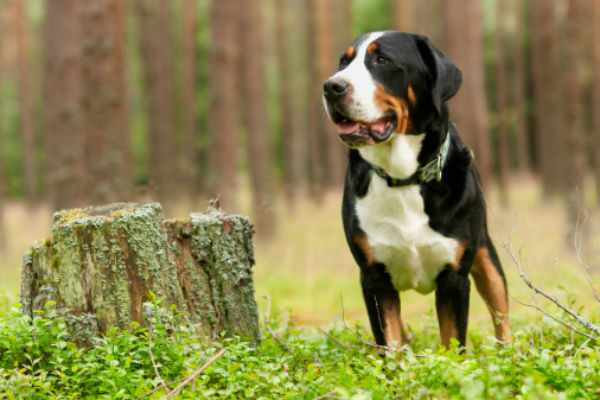
A painting of an Alpine Mastiff which was brought to Britain in 1815.
The origin of the Greater Swiss Mountain Dog is not known. Beginning in 1515, the remote valleys of Switzerland were more or less isolated from world history for three centuries. Specific dog breeds were created by inbreeding, and puppies were given to neighbours and family members.
There are several theories regarding the origin of the four Sennenhund breeds. The most popular theory states the dogs are descended from the Molosser, a large Mastiff-type dog, which accompanied the Roman Legions on their invasion of the Alps more than 2000 years ago.
A second theory is that in 1100 BC, the Phoenicians brought a large dog breed with them to settlements in Spain. These dogs later migrated eastward and influenced the development of the Spanish Mastiff, Great Pyrenees, Dogue de Bordeaux, and Sennenhund breeds.
A third possibility is that a large dog breed was indigenous to central Europe during the Neolithic Period when humans grew wild and domestic crops and used domesticated animals. Whether or not a domesticated large breed existed in the Alpine area when the Romans invaded, Greater Swiss Mountain Dogs are almost certainly the result of the mating of native farm dogs with large Mastiff-type dogs brought to Switzerland by foreign settlers. The early ancestors of the Greater Swiss Mountain Dog were used by farmers, herdsmen and merchants in central Europe. The breed was bred as a draught dog to pull heavy carts, to guard and move dairy cattle, and as a watchdog and family companion.
12. White Swiss Shepherd Dog
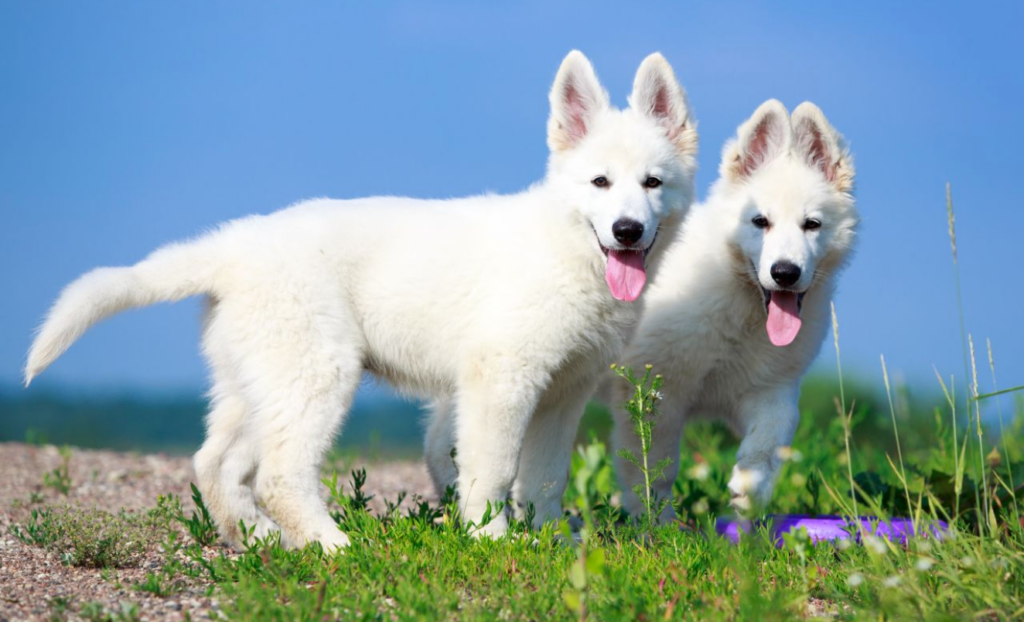
The White Swiss Shepherd Dog (French: Berger Blanc Suisse, German: Weisser Schweizer Schäferhund, Italian: Pastore Svizzero Bianco) is a breed of dog from Switzerland. It descends from American White Shepherds imported to Switzerland, the White Shepherd itself descends from purebred white coloured German Shepherds.
White coloured German Shepherds were once banned from registration in their native Germany, but in the United States and Canada the colouration gained a following and a breed club was formed specifically for white coloured German Shepherds, calling their variety the White Shepherd. The first stud dog of what became the White Swiss Shepherd Dog was an American dog born in 1966 that was imported to Switzerland. The variety was provisionally accepted as a breed by the Fédération Cynologique Internationale in 2002 and received full acceptance in 2011. The Kennel Club of the United Kingdom officially recognized it in 2017.
Its herding abilities are similar to those of the German Shepherd